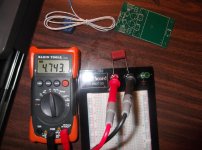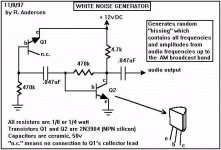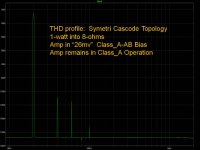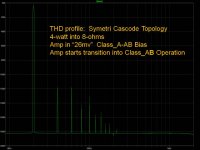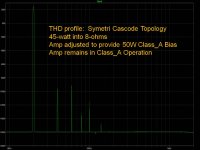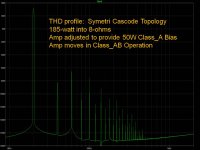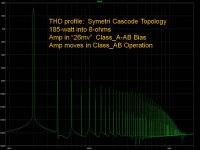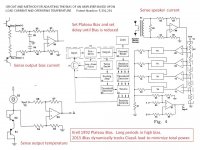I tried Ostripper's design philosophies and Hugh Dean (AKSA)'s design philosophies.
People who call them audiophile tend to like my amplifier which use Hugh Dean (AKSA)'s design philosophies. And sound engineer tend to like my amplifier which use Ostripper's design philosophies.
I personally like my amplifier which use Ostripper's design philosophies. Even i tried combine their design philosophies, make THD as low as possible but harmonic profile must be monotonic or H2 dominant in simulation. Of course slew rate must be high as possible but still have enough good phase and gain margin.
I still did not understand clearly why different amplifier's topology are sound different, although the different is subtle.
People who call them audiophile tend to like my amplifier which use Hugh Dean (AKSA)'s design philosophies. And sound engineer tend to like my amplifier which use Ostripper's design philosophies.
I personally like my amplifier which use Ostripper's design philosophies. Even i tried combine their design philosophies, make THD as low as possible but harmonic profile must be monotonic or H2 dominant in simulation. Of course slew rate must be high as possible but still have enough good phase and gain margin.
I still did not understand clearly why different amplifier's topology are sound different, although the different is subtle.
I tried Ostripper's design philosophies and Hugh Dean (AKSA)'s design philosophies.
People who call them audiophile tend to like my amplifier which use Hugh Dean (AKSA)'s design philosophies. And sound engineer tend to like my amplifier which use Ostripper's design philosophies.
I've tried to combine both philosophies. Hugh's "aska55" type topology
added to the Wolverine (no CCS , bootstrap) was my BX in frugalamp
days.
I ended up with a bootstrap that would still do <30ppm , I liked it's
sound best.
Shunting VAS's with caps and resistors can also "voice" the final
output. You see this on most of my IPS's. It is "available" to set
up many variations to the compensations and VAS loadings.
Most of these trade THD for harmonic content.
Symasui has pads for both capacitive and resistive VAS shunting.
Would be interesting to switch these in and out of a live circuit
on a -120db noise floor FFT at 1K ! (I'm almost there ! )
OS
Wow! This dude ostripper is really prolific. What a great idea to update older designs with modern parts and improved layouts! A friend of mine is interested in doing an EF3 type instrument amp and he wants to use MPSA18's in the IPS. From what I understand, these have a very high hFe and are extremely quiet. Their pinout is unconventional so they won't fit the pre-fabbed boards I've seen here without contorting their legs so a new custom board layout will be required. Can I get a short list of parts to couple with the MPSA18 that will work well with it and not degrade its excellent sonic potential? Also, which of the slewmaster IPS topologies suits the MPSA18 the best?
Wow! This dude ostripper is really prolific. What a great idea to update older designs with modern parts and improved layouts! A friend of mine is interested in doing an EF3 type instrument amp and he wants to use MPSA18's in the IPS. From what I understand, these have a very high hFe and are extremely quiet. Their pinout is unconventional so they won't fit the pre-fabbed boards I've seen here without contorting their legs so a new custom board layout will be required. Can I get a short list of parts to couple with the MPSA18 that will work well with it and not degrade its excellent sonic potential? Also, which of the slewmaster IPS topologies suits the MPSA18 the best?
I did more than upgrade ! Some are quite better. K-ND is unique ....
know of no commercial super-pair cascode - just Vzaichenko's hybrid.
"Prolific" ... NAH ! Thimios and Still4given are the prolific ones.
I (was) just a hack. 🙄
(below)
New test stuff , one of Jwilhelms little PS's (what trafo does it take ?) ,
and a oak board will make for some nice magic smoke.
MPSA 92/42 not too bad (Cob -Ft) ... still not as good as a cascoded
BCxxx or ksa/c 1015/1815 pair. Better for VAS/predrivers.
I've created synthesizer noise generators (below2) , easier to get reverse bias
noise out of 92/42's or 2n2222's. Very hard to get BCxxx to be noisy.
Maybe 1K gain through an op-amp.
Ps - cap meter is cool on that klein DMM ! 😎😎
OS
Attachments
The supply board is designed for a L01-6342 transformer.
L01-6342 Amgis, LLC | TE2246-ND | DigiKey
Hopefully you have better luck than the last transformer.😀
L01-6342 Amgis, LLC | TE2246-ND | DigiKey
Hopefully you have better luck than the last transformer.😀
So I happen to have both E and F hFE class 1381/3503. Any advantage or reason not to use the f rank parts in both the ops and the kypton nd2 ips
Slewmaster - CFA vs. VFA "Rumble"
SCORE after 8700 posts:
VFA = 2 (symasui, Spookyamp V2 ~ "Symetri-Cascode + servo") -->topo shapes harmonic distribution
CFA = 1 (Kypton-ND ~Super NAD CFA) -- >super-pair cascode VAS contribution
SCORE after 8700 posts:
VFA = 2 (symasui, Spookyamp V2 ~ "Symetri-Cascode + servo") -->topo shapes harmonic distribution
CFA = 1 (Kypton-ND ~Super NAD CFA) -- >super-pair cascode VAS contribution
The supply board is designed for a L01-6342 transformer.
L01-6342 Amgis, LLC | TE2246-ND | DigiKey
Hopefully you have better luck than the last transformer.😀
Any in stock ?
OS
So I happen to have both E and F hFE class 1381/3503. Any advantage or reason not to use the f rank parts in both the ops and the kypton nd2 ips
If you have F of both , use them. The stability of the ND should "swallow up"
any beta gain of a superior cascode pair.
OS
Slewmaster - CFA vs. VFA "Rumble"
SCORE after 8700 posts:
VFA = 2 (symasui, Spookyamp V2 ~ "Symetri-Cascode + servo") -->topo shapes harmonic distribution
CFA = 1 (Kypton-ND ~Super NAD CFA) -- >super-pair cascode VAS contribution
Yes , these are the "chosen ones".
It was hard to decide on these , but all topologies had to be explored
to come down to these three. I feel bad to not include some of the other
designs.
PS - go ahead and buy yur' 10K$ audiophile amp. I like 9K$ amps. 😀
OS
All these posts ....
We have absolutely gone beyond any DX or the typical DIY amp. we are
on the verge of "pro".
But we share this with the community - it is NOT proprietary. This is in
the "spirit" of the community.
PS- my next creation might "shame" the commercial sector of diya. I
"hold back" many IP's (won't include them) in my designs.
I have more designs , but wonder how (SQ wise) ...I can beat the current
ones ? Maybe with another "groog" , I can trick my brain out to attempt
this ?
OS
We have absolutely gone beyond any DX or the typical DIY amp. we are
on the verge of "pro".
But we share this with the community - it is NOT proprietary. This is in
the "spirit" of the community.
PS- my next creation might "shame" the commercial sector of diya. I
"hold back" many IP's (won't include them) in my designs.
I have more designs , but wonder how (SQ wise) ...I can beat the current
ones ? Maybe with another "groog" , I can trick my brain out to attempt
this ?
OS
Hi os i AM building slewmaster 2, do you have any advices for component chances New resistor value? Compared to 3rd edition?
Yes the components "around the output / driver /predriver stage"
I will use mjl4302 + 2sa1606 + 2sc3503 for power - driver and pre driver stage.
Just if you if have any advices for bias current (2 pair outputstage), emitter resistor size - example the resistor between the emitters in driver stage??
Thanks
I will use mjl4302 + 2sa1606 + 2sc3503 for power - driver and pre driver stage.
Just if you if have any advices for bias current (2 pair outputstage), emitter resistor size - example the resistor between the emitters in driver stage??
Thanks
Last edited:
Hi Os!
I follow this yours great thread from far start ,
I wonder why you do not explore & design some high power PP balanced bridge ( Circlotron ) AB-class OPS using only N type power devices , Fet`s or BJT`s ,
and to get SS -Circlotron HQ power amp , CFA or VFA based .
----------------------------------------------------------------
Again many thanks for really all great designs you have showed here !

I follow this yours great thread from far start ,
I wonder why you do not explore & design some high power PP balanced bridge ( Circlotron ) AB-class OPS using only N type power devices , Fet`s or BJT`s ,
and to get SS -Circlotron HQ power amp , CFA or VFA based .
----------------------------------------------------------------
Again many thanks for really all great designs you have showed here !

Should the Slewmaster - CFA vs. VFA "Rumble" include "smart bias" technology?
The shape of the THD profile has become a major good/bad decision criteria.
The shape of the THD profile is very different in Class-A bias than in Class-AB bias.
Sliding Bias and Plateau Bias technologies promise favorable THD profiles with modest SQ difference, and modest inefficiency in power dissipation.
Attached a few LTspice THD profile graphs for the Symetri-Cascode topology with the "26mv" perfect Class-A_AB bias, and also with enough Class-A bias to cover 50W into 8-ohms. Naturally, the THD profiles are "favorable" when the power demands are below the Class-A bias power limit. THD sims for 185W into 8-ohms Class-AB only are included.
-------------------
A few of my amplifiers have a 2-bias point switch option:
1) The Barney Oliver 26mv optimal Class-A_AB bias which provides about 5 watts of "clean THD profile" Class-A power before sliding into Class-AB operation; and
2) a mechanical switch for 50 watts of Class-A bias to heat the living room. The amp slides into Class-AB bias above 50W.
My big Krell VFA amps use a sliding Plateau Bias which senses large current demands at the Vbe circuit and "immediately" increases bias current for a "short period" before testing for "safe bias reductions". Krell has just patented iBias which uses a microprocessor to control the bias algorithm for Krells new CFA topology amps.(2014) Krell has completed a VFA --> CFA "Product Rumble".
The shape of the THD profile has become a major good/bad decision criteria.
The shape of the THD profile is very different in Class-A bias than in Class-AB bias.
Sliding Bias and Plateau Bias technologies promise favorable THD profiles with modest SQ difference, and modest inefficiency in power dissipation.
Attached a few LTspice THD profile graphs for the Symetri-Cascode topology with the "26mv" perfect Class-A_AB bias, and also with enough Class-A bias to cover 50W into 8-ohms. Naturally, the THD profiles are "favorable" when the power demands are below the Class-A bias power limit. THD sims for 185W into 8-ohms Class-AB only are included.
-------------------
A few of my amplifiers have a 2-bias point switch option:
1) The Barney Oliver 26mv optimal Class-A_AB bias which provides about 5 watts of "clean THD profile" Class-A power before sliding into Class-AB operation; and
2) a mechanical switch for 50 watts of Class-A bias to heat the living room. The amp slides into Class-AB bias above 50W.
My big Krell VFA amps use a sliding Plateau Bias which senses large current demands at the Vbe circuit and "immediately" increases bias current for a "short period" before testing for "safe bias reductions". Krell has just patented iBias which uses a microprocessor to control the bias algorithm for Krells new CFA topology amps.(2014) Krell has completed a VFA --> CFA "Product Rumble".
Attachments
Well, i believe we should prefer total HD under any audible threshold level than any "good profile" at a higher level.The shape of the THD profile has become a major good/bad decision criteria.
Should the Slewmaster - CFA vs. VFA "Rumble" include "smart bias" technology?
The shape of the THD profile has become a major good/bad decision criteria.
The shape of the THD profile is very different in Class-A bias than in Class-AB bias.
Sliding Bias and Plateau Bias technologies promise favorable THD profiles with modest SQ difference, and modest inefficiency in power dissipation.
Attached a few LTspice THD profile graphs for the Symetri-Cascode topology with the "26mv" perfect Class-A_AB bias, and also with enough Class-A bias to cover 50W into 8-ohms. Naturally, the THD profiles are "favorable" when the power demands are below the Class-A bias power limit. THD sims for 185W into 8-ohms Class-AB only are included.
-------------------
A few of my amplifiers have a 2-bias point switch option:
1) The Barney Oliver 26mv optimal Class-A_AB bias which provides about 5 watts of "clean THD profile" Class-A power before sliding into Class-AB operation; and
2) a mechanical switch for 50 watts of Class-A bias to heat the living room. The amp slides into Class-AB bias above 50W.
My big Krell VFA amps use a sliding Plateau Bias which senses large current demands at the Vbe circuit and "immediately" increases bias current for a "short period" before testing for "safe bias reductions". Krell has just patented iBias which uses a microprocessor to control the bias algorithm for Krells new CFA topology amps.(2014) Krell has completed a VFA --> CFA "Product Rumble".
Your simulations reflect mine in A and AB.
I used the slewmonster 5 pair VFET OPS overbiased to simulate an amp. This , and
an over-sized heatsink ... would be a better testing ground for high power
class A operation.
The resistor in series with the bias trimmer of the slew OPS could just as
easily be a (switched) lower value resistance to toggle the VFETS over >500ma - (or higher) bias.
OS
- Home
- Amplifiers
- Solid State
- Slewmaster - CFA vs. VFA "Rumble"
